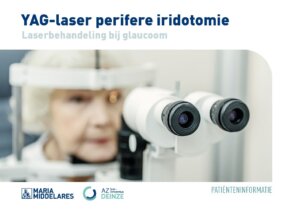YAG Laser Periferal Iridotomy
What is it?
What is it?Glaucoma is an eye disorder in which a person gradually loses fibres of the optic nerve, usually due to elevated eye pressure. Eye pressure should be (consistently) reduced and/or sudden pressure increases should be prevented. A peripheral iridotomy can be performed to achieve these goals.
Cause of glaucoma
The eye produces fluid (aqueous humour) to nourish the cornea and lens. This chamber water leaves the eye unnoticed through a drain located at the border of the white of the eye (sclera) and the coloured portion of the eye, the iris. If this duct (trabecular network) works less efficiently, it becomes more difficult to remove the aqueous humour and the interior eye pressure starts to increase. This can slowly but surely damage the optical nerve. until you finally notice that there are portions of your vision missing (from the visual field). Visual acuity can later be affected. This disease is called glaucoma, and it is irreversible. It can only be slowed.
Glaucoma is divided into two types: open--chamber angle glaucoma and closed-chamber angle glaucoma. If your physician wishes to perform a peripheral iridotomy, it is usually because the glaucoma is the second type.
Treatment goals
Eye pressure should be (consistently) reduced and/or sudden pressure increases should be prevented. A peripheral iridotomy can be performed to achieve these goals. During this laser treatment, a thin beam of light (laser light) is used to create a small hole in the iris, which prevents an episode of high eye pressure. The goal of the treatment is to keep the eye pressure low and thus preserve the visual field and visual acuity, not to improve it. Since most people have eyes that are similarly formed (and affected by similar risk factors), a laser treatment is usually performed on both eyes.
What is the process?
What is the process?Before the treatment
In preparation for treatment, you will receive eye drops to reduce the pupil size and sometimes a tablet to preventively lower eye pressure. The drops sometimes cause a slight headache and blur your vision somewhat. You will also be given a drop that slightly lowers eye pressure. The drops take thirty minutes to take effect.
Treatment
The laser treatment is performed in a separate, darkened room. You sit on a chair, place your chin in the chin rest and support your forehead against a bar. The ophthalmologist numbs the cornea with eye drops, and a contact lens is placed on your eye. This is not painful. Using the contact lens, the laser light makes a tiny hole in the iris. The laser treatment is painless and lasts only a few minutes. The physician usually decides to not treat both eyes on the same day.
Result
A peripheral iridotomy is not visible from the outer surface of the eye. The treatment is almost always successful. A repeat treatment is required only in exceptions.
The treatment has no direct impact on your vision. You will not see better after the treatment, for example. The primary goals is to keep the eye pressure low.
After the treatment
The eye drops and the treatment may reduce your vision temporarily. For this reason, you may not drive a car and must bring someone with you who will take you home after the treatment.
Sometimes your physician will want to check your eye pressure approximately an hour after the treatment.
There are no specific rules for after the laser treatment. If you use eye pressure-lowering drops and/or tablets, you can continue them without any changes. You should use anti-inflammatory eye drops for one week.
Check-up
There will be a check-up at the outpatient clinic after the laser treatment. The ophthalmologist will let you know when you should have a check-up.
Only available in Dutch:

YAG-laser perifere iridotomie - Laserbehandeling bij glaucoom
DownloadCentres and specialist areas
Centres and specialist areas
Something wrong or unclear on this page? Report it.
Latest publication date: 13/08/2024
Supervising author: Dr. Vanwynsberghe David





